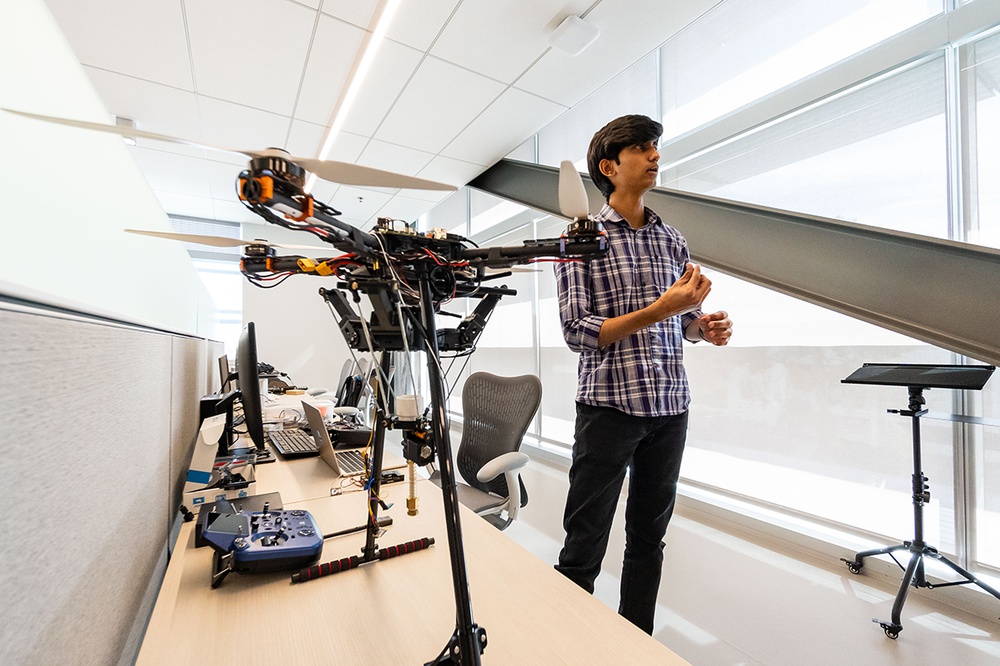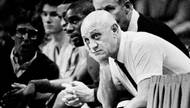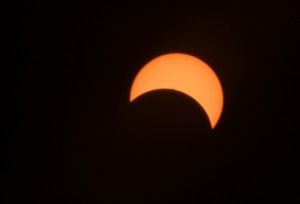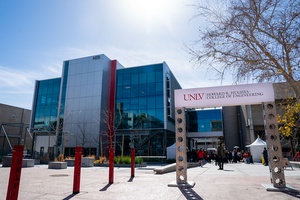Mugundan Prakash moved to the United States from India last July to complete his degree, and he couldn’t imagine doing it at a better place than UNLV, he said. The 21-year-old graduate student, who majors in electrical engineering, has spent the past couple of months working on a drone that can test the soil of places affected by wildfires.
Fellow graduate student Breanna Geller, a computer science major, has taken more to land-based inventions. Her work involves creating an autonomous race car, and her current goal is to create a team on campus that travels internationally with their creation—roughly the size of a remote-controlled (RC) toy car. It’s the first invention of its kind at UNLV, she said.
Geller and Prakash began their graduate projects late last year, and while their disciplines may not have merged previously, they’ll have more opportunities now with the completion of UNLV’s Advanced Engineering Building.
“It’s awesome,” Geller said of the new building. “I think there’s a lot of ingenuity in the building and they had so many great ideas … (and) it’s super nice to have somebody next to you who’s an electrical engineer and be like, ‘I don’t know what this does, can you explain it?’”
The Advanced Engineering Building (AEB) bolsters UNLV’s effort to become a technology hub for the state.
On Feb. 23, UNLV debuted the building — a three-story, 52,000 square-foot “idea incubator and innovation generator” constructed next to the Thomas T. Beam Engineering Complex toward the northeast corner of campus.
The structure, with its sleek, metallic design and many open windows, adds to the Howard R. Hughes College of Engineering that was established in 1976 though it gained standalone status in 1988.
University officials and state leaders believe the Advanced Engineering Building will “drive innovation” in Southern Nevada. A 25% increase in the enrollment of engineering and computer science students is expected by 2030, said College of Engineering Dean Rama Venkat.
“This Advanced Engineering Building will allow us to sustain our growth and support our vision for a bright and exciting future for the college, the campus and the community,” Venkat said.
Venkat, who gave remarks at the building’s opening ceremony, said the new building was “designed to be student-centered and collaboration focused,” with open wet and dry laboratories for students to share research.
The computational and dry lab will be used for projects on emerging securities technologies including robotics, circuit design and cybersecurity, whereas the wet labs will provide space for research on water resources management, energy solutions and biomedical applications.
There’s also the first-of-its-kind flexatorium classroom, a spacious lecture hall with auditorium-style seating that folds up to convert the classroom into an event or research space when needed. Geller, who works in the flexatorium, said she often uses the room to set up the track for her autonomous race car.
Another highlight is the collaborative Maker Space — with 3D printing and laser cutting technology among others as well as “accordion-style” doors to help students easily transport their projects — or the drone aviary for students to practice in sectioned-off flight space.
The building will also be a boon to UNLV and Southern Nevada as a whole, Venkat explained. About two-thirds of UNLV engineering graduates will find well-paying technology jobs in Nevada, and research done in the Advanced Engineering Building will “fuel the creation of startups in the valley,” said Venkat.
Venkat expects that faculty, which received $17 million in research grants last year, the largest in the college’s history, will gain even more support through the work they can do in this new building. He expects by 2030 to pull in $25 billion in research grants.
In remarks given at the grand opening, UNLV President Keith Whitfield said the building will be a hub for innovations and solution-based research.
“The ideas and the research that are going to come from this building are going to be able to drive solutions and innovations that are going to forge pathways that allow us to adapt, thrive and overcome,” Whitfield said. “This state-of-the-art facility reflects the university’s commitment to staying at the forefront of technological advancements.”
He added that the AEB will not only provide classroom space for students, but also will provide them with more opportunities for success as well as access — to both modern tools and collaborative projects.
The building won’t be open for classes until fall 2024, but students have already begun making use of the space for their projects, or even just to study.
On the day of the grand opening, Prakash had his soil-testing drone placed on a standee atop a new desk within the AEB’s second floor. It had only been a few weeks since he moved from the Science and Engineering Building into the AEB and some of his equipment was still stowed away in cardboard boxes.
“No matter whatever the things we need, they’re getting us all the things. … We are able to work on our project very quickly, which makes the completion of the project easy,” Prakash said of his experience moving into the Advanced Engineering Building, noting that the cutting-edge tools and large spaces help.
The projected growth rate for technology jobs in the United States over the next 10 years is nearly twice the national jobs rate, according to the 2023 State of the Tech Workforce report done by CompTIA, an information technology certifying organization. About 48,600 people in Nevada held a technology job or worked in the industry last year, with software and IT support specialists being the most common roles.
Local leaders believe that sector is set to grow, especially as Southern Nevada welcomes more companies into the region — like Haas Automation and Brightline West — and utilizes the expanding tech industry to diversify the economy.
“We know that Las Vegas is known around the world as the entertainment and sports capital of the world, but now for generations to come, we will also be known as the hub for cutting-edge science and technology,” said Nevada Congresswoman Susie Lee at the opening.
Click HERE to subscribe for free to the Weekly Fix, the digital edition of Las Vegas Weekly! Stay up to date with the latest on Las Vegas concerts, shows, restaurants, bars and more, sent directly to your inbox!






